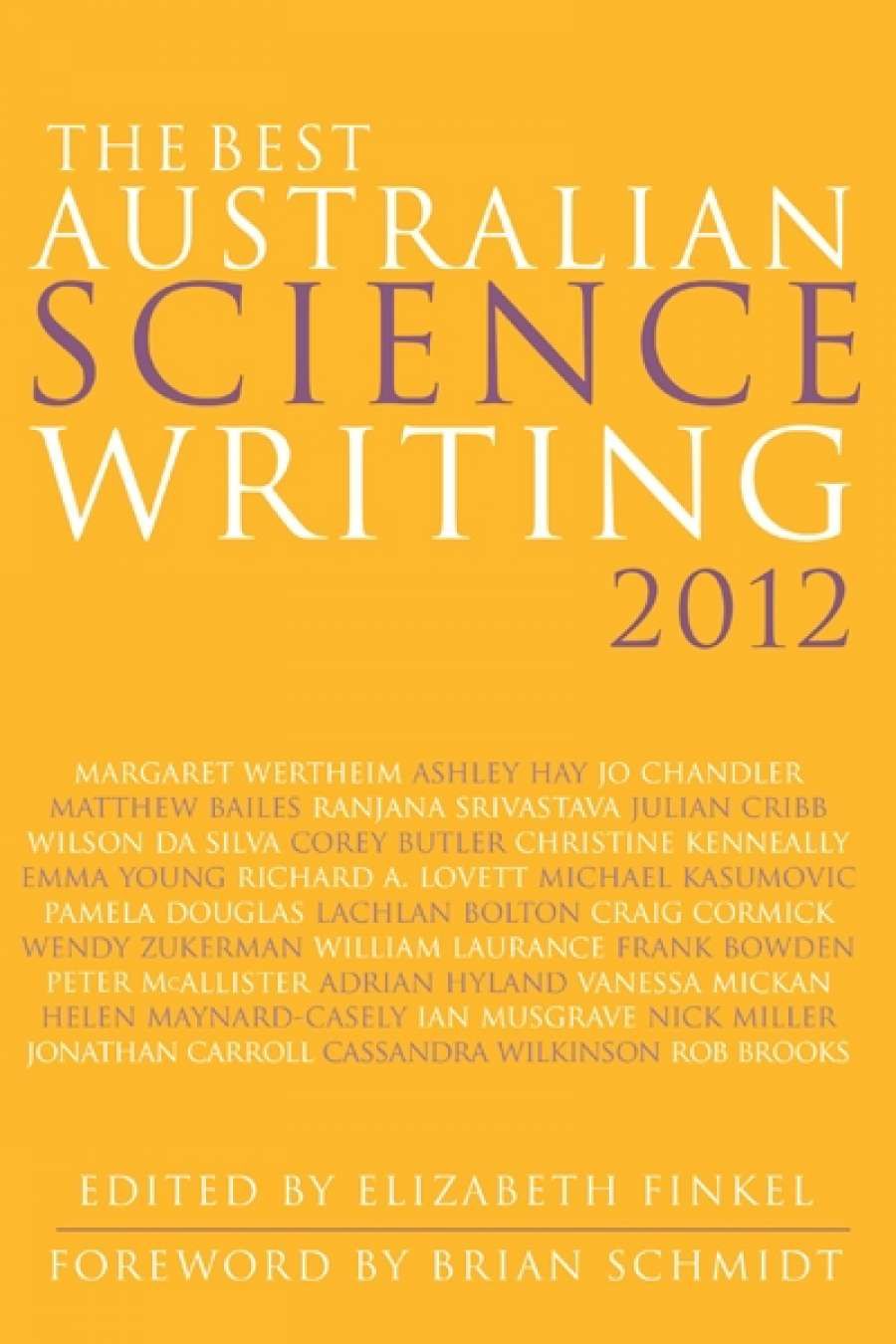
- Free Article: No
- Contents Category: Science and Technology
- Review Article: Yes
- Online Only: No
- Custom Highlight Text:
This is a marvellous book. I would say that, wouldn’t I? After all, half the writers are friends of mine, including the editor. But the reverse is true. Why should I, immersed in astrophysics, climate change, neutrinos, and deadly bugs as I am, want to spend my precious spare time reading about yet more? And, let’s be quite frank, lots of science writing can be dense, overlong, and, as the wonderfully morose James Thurber once remarked, ‘teaching me more than I ever wanted to know about ferrets’. Well, there are no ferrets in this collection, but just about everything else, from peeing in the pool to watching the space shuttle take off.
- Book 1 Title: The Best Australian Science Writing 2012
- Book 1 Biblio: NewSouth Publishing, $29.99 pb, 295 pp, 9781742233482
The answer for me, as it would be for any general reader, is variety, storytelling, and, most of all, surprises. Do you know what happens, chemically, when a person urinates in a jacuzzi? The author, aged twelve (!), explains. Are you aware that computer game players are more likely to pass exams with honours? Neither did I, although the author, Michael Kasumovic, a post-doc fellow at the University of New South Wales, admits that the games may have been given to offspring by parents as a reward for studies well done.
Did you know that EBM, treasured by the cognoscenti as ‘evidence-based medicine’, is seen by some doctors as a narrow élitist plot against a more inclusive approach to understanding effective treatment? Evidence, surely, is simply that: tested information gathered widely. Not so, writes GP Pamela Douglas, in a long piece that tries to fathom what makes screaming babies cry. EBM, she claims, is evidence produced by trials: banks of stats making significant indicators – or not. It ignores experience, case studies, and related physiological insights. Numbers aren’t everything.
Her essay is intriguing. Is the baby bawling because of a tummy upset (colic)? Or could it be normal? (I have always thought babies just hate us and like to torment us.) Is one of the treatments a likely cause of lifelong digestive malady? The stakes are enormous, and we are once again astounded that something so common can still stump scientists in this cleversticks twenty-first century. Whatever the answer, I wish Douglas had spared us quite so many marching acronyms: EBM, GORD, PPI, PHCRED … Argh!
But fear not, these are rare blemishes in a book full of pellucid prose. One gem comes, of course, from Margaret Wertheim. She is trained in maths and physics, but has spent most of her life as a writer of books such as the seminal Pythagoras’ Trousers (1995). Here she tells the story of doing something I would never dream of: making friends with uninvited interlocutors who have their own elaborate theories of The Universe and Everything and Where Einstein Went Wrong. Wertheim collects them, replies to their letters; she even goes to see them. And here she explains why she, Paul Davies, and I get so very many enormous screeds every week of these outlandish, irrefutable cosmologies. It’s the black box syndrome.
Her favourite‘theorist’ is Jim Carter. Wertheim finds him at a trailer park in Enumclaw forty-eight kilometres from Tacoma, in Washington State. He collects old cars. Nowadays, if you open the hood of a car, the back of a telly, or the body of the machine on which I’m typing this – you encounter nothing that even a handy tinkerer could recognise or fix – just another black box. And so it is with Einstein, quantum physics, and twenty-first-century cosmologies. They have left the rest of us behind. So Jim Carter looks down at the black boxes, refuses to confront the arcane complexities of the maths and physics that created them, and invents his own more homely version instead. Margaret Wertheim tells his story with charm and understanding.
She, like Jo Chandler, is a professional writer. Chandler takes us on a southern trek to fathom what’s happening with climate. It is done with her usual command of fact and atmosphere and is one of several pieces tackling climate. Matthew Bailes, an astronomer, compares the reception of climate science with his own announcement of the discovery of a diamond planet. The latter, however phantasmagorical, is received with no adverse comment; climate science, despite 150 years of massive evidence, is kicked like a political football.
And that is the interesting paradox in this anthology, not the contentious nature of the ideas, but the number of working scientists contributing to it. They nearly outnumber the professional writers. Chandler has now left Fairfax, where once you could find any number of science journalists; only one ABC staffer, Wendy Zukerman, makes a welcome appearance on this list. I myself am writing here, what will be my first paid article of 2012, having had only one other piece published – in a magazine that promptly closed. It has been the leanest season in memory.
So where will the best science writing come from in 2013 and beyond as science journos gradually follow the dodo? On the present evidence, it will come from scientists themselves, writing online, or for the magnificent Cosmos magazine, or in books such as Wertheim’s.
The talent is there. May it continue to be displayed. Somehow.


Comments powered by CComment